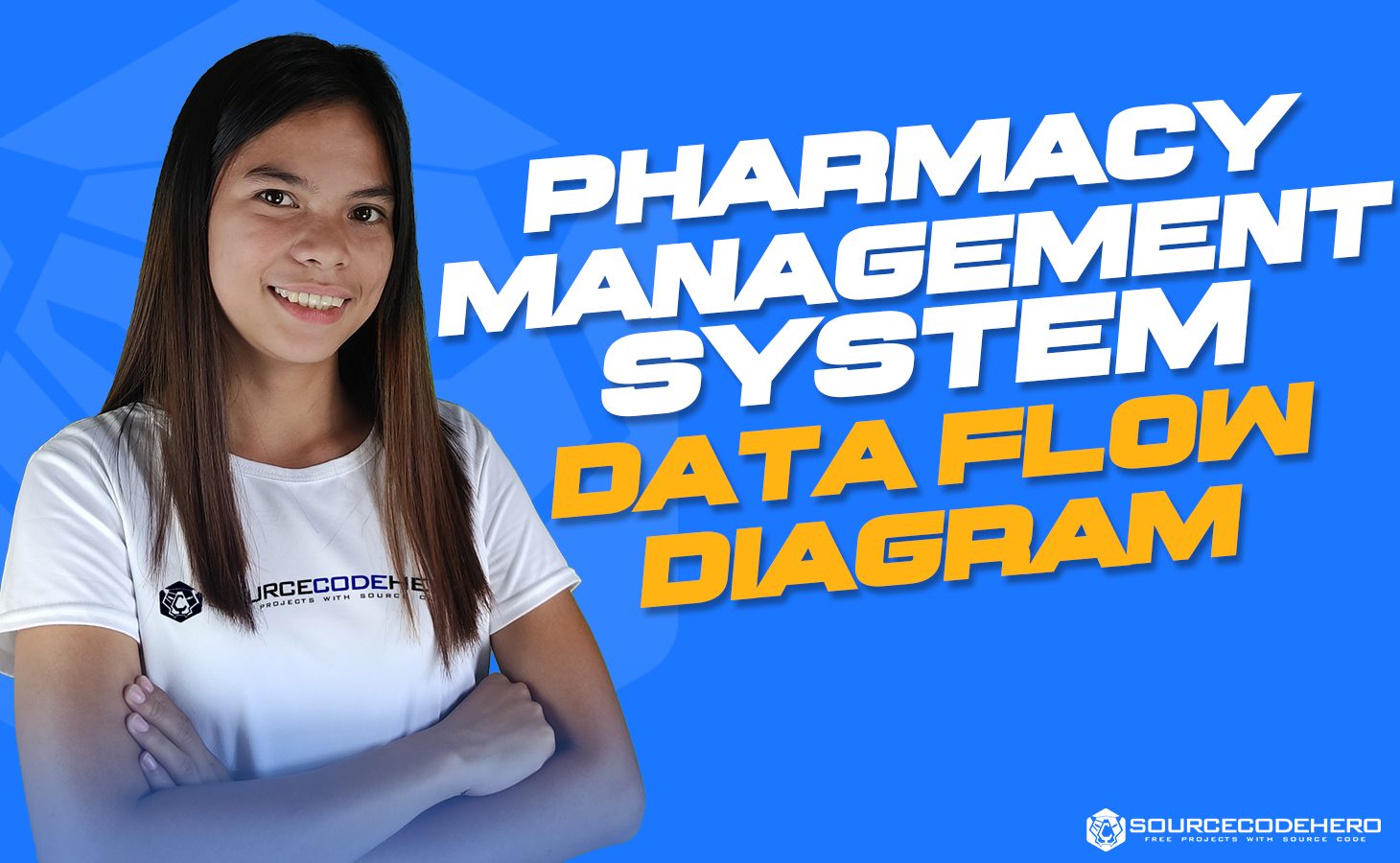The DFD (Data Flow Diagram) for Pharmacy Management System explains the “flow” of information on the project. It is used to record the transformation of data (input-output) for the development of a project.
The pharmacy management system DFD consists of DFD levels 0, 1, and 2. Additionally, it utilizes entities, processes, and data that define the whole system.
Pharmacy Management System Data Flow Diagram: Details
The table shows the overview and details of the data flow diagram (DFD) for pharmacy management system. It has complete information about the project.
| Name: | Pharmacy Management System (DFD) Data Flow Diagram |
| Abstract: | The pharmacy management system data flow diagram (DFD) shows the structure of the project in terms of its data management. It contains the important details on the flow of data and alternatives done in the project. |
| Diagram: | Data Flow Diagram (DFD) |
| Users: | School Admin, Students, Staff, and Visitors. |
| Tools Used: | You may use any Diagram tools that provide data flow diagram symbols. |
| Designer: | Sourcecodehero.com |
What is a Pharmacy Management System?
A pharmacy management system helps pharmacies run their business well. It helps them keep track of how much medicine and ale they have on hand. The system also lets pharmacists know when prices need to go up.
A customer can also use this system to do business without the help of a person. So, this system is very helpful in many ways for managing a pharmacy.
What is Pharmacy Management System DFD?
The DFD is one of the ways that employee attendance management systems are made (data flow diagram). It shows the system’s main processes and options that make the data flow inside the system.
Furthermore, the data was in the right categories to show the structure of the pharmacy management system. Note that DFD is not part of the Pharmacy Management System UML Diagrams. However, they both help explain the activities, behaviors, interactions, and structure of the project.
Importance of Data Flow Diagram (DFD)
The data flow diagram (DFD) for a pharmacy management system is important because it shows the developers what is really going on in the system. This is done by seeing how the system manages data at different levels.
Furthermore, the DFD levels utilize the flow of data in the employee attendance system. These levels do their part to explain how the data flows through the system. It is then applied in creating Pharmacy Management System ER Diagram.
Data flow diagrams not only show how data moves from one process to another, but they also show the steps that are taken to move data from one process to another. So, the data went from being input to being output.
Advantages of Data Flow Diagram:
The Advantages of the Pharmacy Management System Data Flow Diagram are as follows:
- It facilitates the display of system contents.
- Included in the documentation file for the system.
- Simple to comprehend and understand by both programmers and users.
- DFDs are complete and well-explained representations of system components.
- It also assists in knowing the functioning and limits of a system.
Pharmacy Management System Data Flow Diagram (DFD)
The presented sample data flow diagram for the data flow diagram for pharmacy management system is with a detailed explanation. This instance highlights the three DFD levels (DFD Levels 0, 1, and 2).
0 Level DFD for Pharmacy Management System
The context diagram is an alternate term for DFD Level 0 of the Pharmacy Management System. Composed of users, the primary process, and data flow. Additionally, visualization of the idea of the project is via a single process.
Level 0 of the DFD identifies the entities that interact with a system and the boundary between the system and its environment. This figure also provides an overview of the pharmaceutical management system.
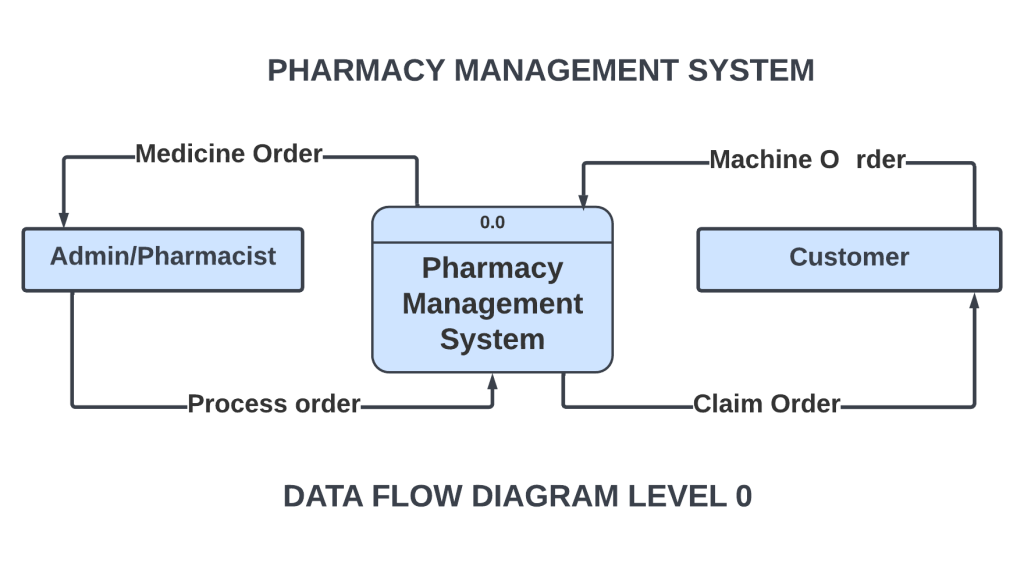
To explain the project context, the diagrams show the primary process as a single node. This background illustrates in a single glance how the project operates. The user inputs data into the system before receiving the output.
Moreover, you will see via the graphic that data flow is already present. Although the procedure is quite generic, the data flow is transparent. However, just adapt this design to match the other standards and incorporate other pharmacy management-related details.
Level 1 DFD for Pharmacy Management System
The “detonated view” of the context diagram is Employee Attendance Management System DFD Level 1. Its purpose is to expand upon the notion deduced from the context diagram.
Specifically, level 1 demonstrates the larger aspects of level 0 of the Pharmacy Management System DFD. This is intended to clarify the pathways (flow) and transformation of data from input to output.
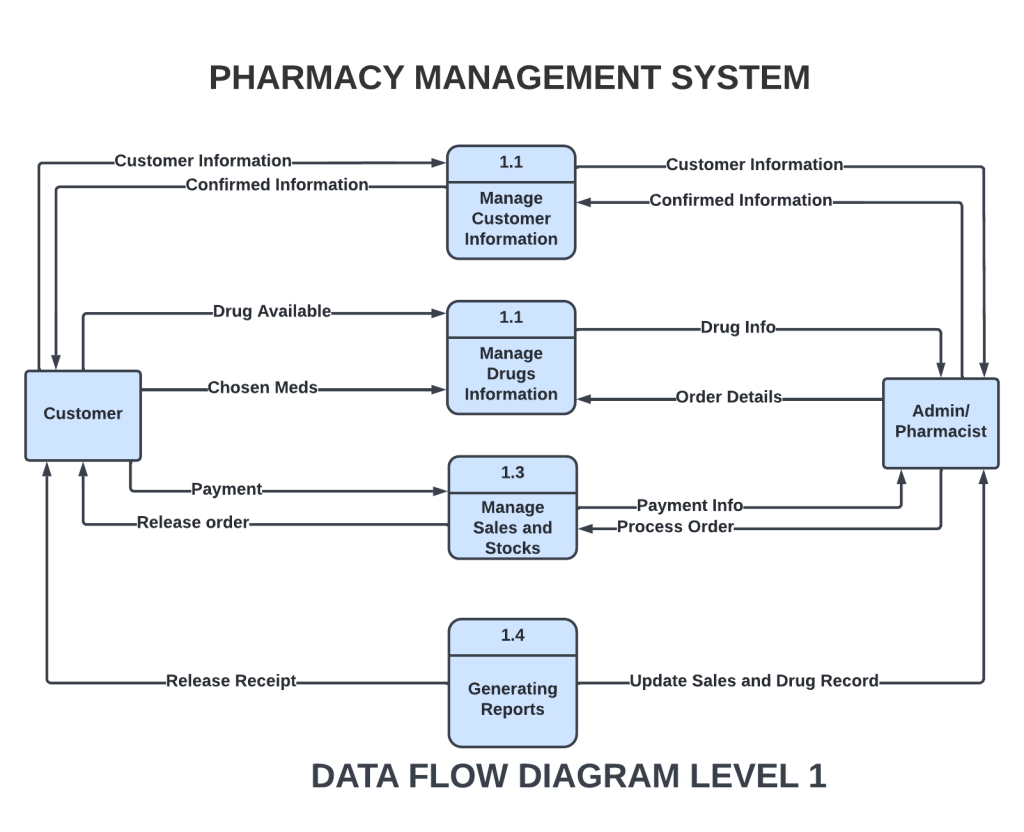
The diagram shows four different situations: managing customer information, managing orders or reservations, planning delivery times, and managing transactions and payments.
First of all, the flow of data starts with the admin or owners of the restaurant and the customers. The system then handles the transaction. The idea is based on how pharmacies run or what transactions they do.
You can also look at the data store or database that is being used. The database is used to store the information that users put and to make outputs.
Level 2 DFD for Pharmacy Management System
Level 2 of the data flow diagram for the Pharmacy Management System is also the most general. This level also takes the idea from DFD level 1 and makes it bigger. It includes the sub-processes from level 1 and the data that flows.
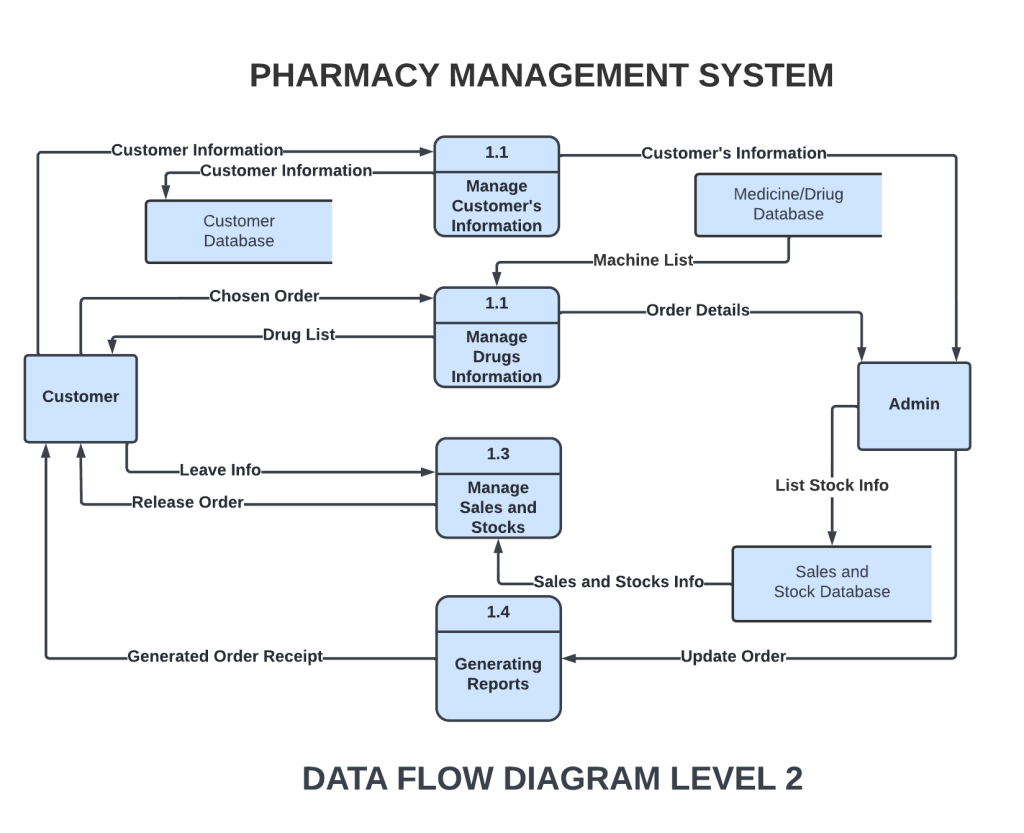
But not every process in the project needs to have a sub-process. Only show this diagram if you have to. As long as the diagrams you’ve made before are clear and accurate, you don’t need to do this level.
You can add to this, and how you make your data flow diagram is up to you. Also, think about how the data flows and make sure your information is correct.
Pharmacy Management System Data Flow Diagram Pdf
Click the button below to get the Data Flow Diagram for Pharmacy Management System as a PDF file. It has everything you need to know about the System’s Data Flow Diagram and how it works. You can also change its content to meet the needs and requirements of your project.
Data Flow Diagram Notations:
We used DFD notations to explain how the data flow diagram works. The symbols presented were easy to understand. These things are the following:
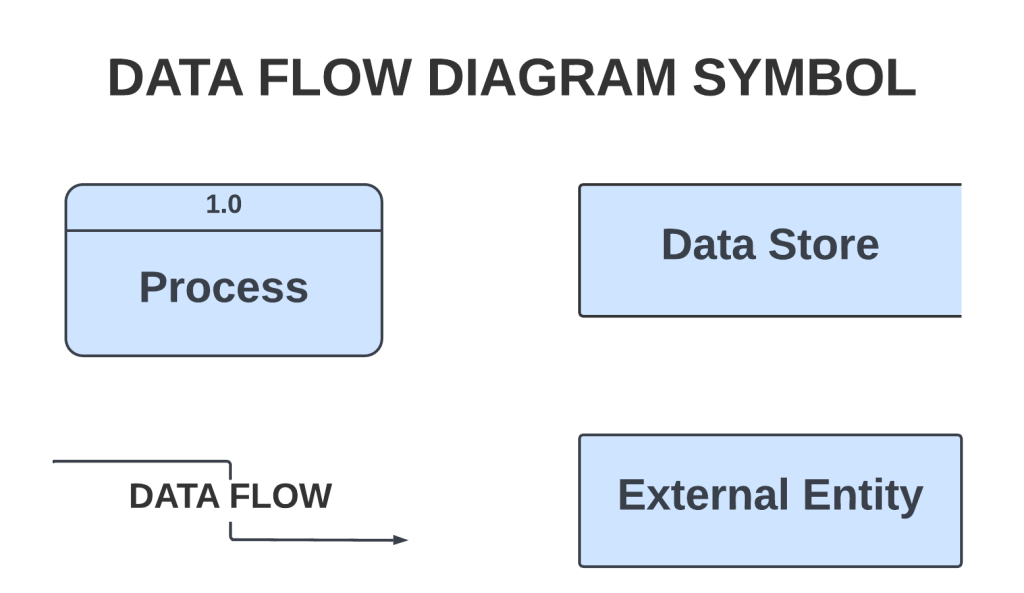
- External Entity: provides or receives information and communicates with the system. They are where data comes from and goes when it enters or leaves the system. A third-party company or person, a computer system, or a business system could also be an entity. People use the words terminators, sources, sinks, and actors to talk about entities.
- Process: is the part of DFD that changes data and makes something new. It also does calculations, sorts data based on logic, or controls the flow of data based on business standards.
- Data Store: A database table or a membership form are examples of files or other places where information can be stored for later use.
- Data Flow: is the route that data takes between outside entities, processes, and data stores. It shows how the other parts connect to each other. It is indicated by arrows and labeled next to them.
These signs on the data flow diagram indicate how each and every piece of data is handled. Using these Data Flow Diagram symbols would also help describe the system’s architecture.
How to Create Data Flow Diagram?
Time needed: 5 minutes
Here’s the simplest way to create your DFD diagram for Pharmacy Management System.
- Step 1: Familiarize Data Flow Diagram (DFD) Symbols
Data flow diagrams show how information moves through a system or process. It also includes data inputs and outputs, as well as data stores and users. Before you make the actual diagram, you need to know what its symbols mean and how to use them.
- Step 2: Analyze the processes and data included
When making a data flow diagram, analysis is a very important step. It also helps you figure out what the diagram means and avoid making mistakes.
When making the diagram, the information from the users is very helpful. You must also look at the data and decide on the general processes.
From the general processes, you’ll be able to see what kinds of data could go into and out of the system. But only user information and processes that have to do with logging in are included. Then you are ready to move on. - Step 3: Plot the Data Flow Diagram
We will need the users, processes, databases, and data flows to make the data flow diagram. Then, we’ll use the evaluated information to figure out how the data should flow to get the exact data flow diagram.
First, we need to know who will be using the system and what their main tasks will be. First, this will make the DFD Level 0 diagram, also called the context diagram.
Then In DFD Level 0, we’ll get more into the idea. To do this, we will need to figure out the smaller steps that are needed to finish the main step. We will also add a data store where the data that has been processed will be kept.
After that, we’ll follow the flow or path of data to find out how data inputs are changed into data outputs. This will make Level 1 of the DFD.
Lastly, Adding the supporting processes in DFD Level 1 brings DFD to a close. We’ll connect them to the existing level to make the data flow diagram more detailed.
Conclusion
In conclusion, we have reviewed the knowledge required to design a data flow diagram. Its primary objective is to focus on data transformation from input to output. In addition, DFD levels were extremely helpful in developing the system.
Additionally, the material was suitably classified. It emphasizes the organization of the pharmacy management system. This documentation will assist not only with the project’s basis but also with its behavior. Check out these linked and suggested articles for additional information!
Inquiries
If you have inquiries or suggestions about DFD Diagram for Pharmacy Management System, just leave us your comments below. We would be glad to hear to concerns and suggestions and be part of your learning.
Keep us updated and Good day!
